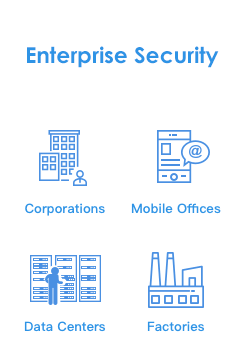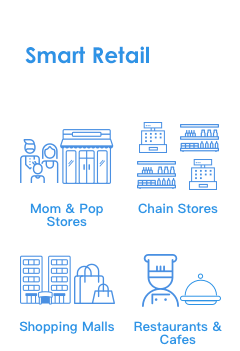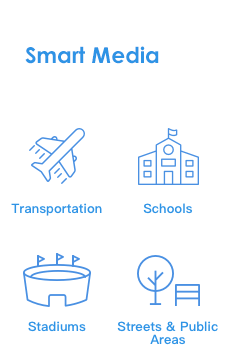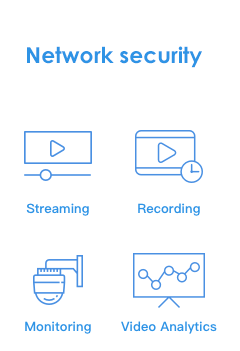Exploring Technology and Terms: Edge Computing, Edge AI, IoT
We hear these words all over the place: edge computing, edge AI, IoT, video analytics, etc. Every day in tech company event pages, articles from news outlets, personal blog posts, social media blurbs, even images on photo sites are littered with so many tech terms and acronyms it’s a wonder that any one person could possibly understand what they all mean.
It’s understandable that as time and technologies progress, tech companies fragment and are creating an unfathomable sea of niche solutions. While this happens, being able to concisely describe this new tech is imperative to community understanding and of course, the bottom line of making sales.
In this article, we’ll explore and describe some of the terms that directly relate to what we do here at Gorilla. The reason we’re writing this is simple—Gorilla believes giving everyone a solid understanding of certain tech-speak through education and discussion is vital to progress and growth.
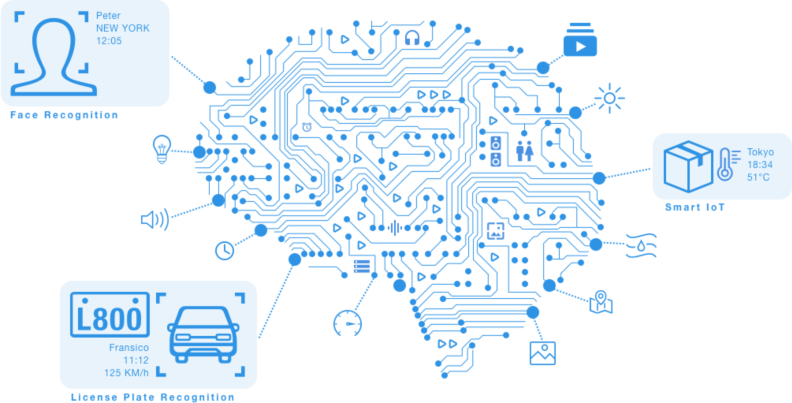
Ideas Behind Edge Computing and Edge AI
It’s an incredibly interesting idea that words have histories of their own, that there are different types of dictionaries, and that language is what we as a society make it. With that in mind, let’s go into what these words look like when they’re alone and then when they’re put together.
Edge
This one’s pretty straight forward as its history isn’t based in tech, but what does it mean when we apply it to technology and computer systems?
Edge, when talking about tech things, is generally referring to devices which provide an entry point for data from the real world to go into a digital system or network.
Let’s go over ideas like computing and AI before we get into what it means when we attach the word ‘edge’ in front of them.
Computing
We, as a society, have been using compute and its conjugated forms for about four hundred years and like many words from around then, it comes from Latin [com ‘with, together’ and putare ‘to reckon’].
It follows that compute means to count or sum up, which is exactly what computers do. Adding the -ing to compute shows us that the computer or device is actively doing that, and in a lot of cases they are computing 24/7.
AI
It’s fairly safe to say that more than half of the world understands that the acronym AI means Artificial Intelligence.
AI is defined as the capacity of machines (usually computers) to exhibit intelligent behavior. The phrase was coined in 1956 and the ‘artificial’ part of it was meant to emphasize the belief that human intelligence is real and machine intelligence is not. Over the course of its (relatively short) life, AI has segmented into categories in which the intelligence side is different, e.g. machine learning, deep learning, computer vision, facial recognition, behavior analysis, etc… But that’s for a different article. When all is said and done, AI is software that runs on hardware.
Now that we have a pretty good (albeit basic) foundation of edge, computing, and AI, let’s put these together and look at edge computing and edge AI.
Edge Computing
So we now know that edge devices are near to or act as the entry point for data into a network or system.
Before edge computing came along, these devices were conduits which sent data gathered to the central network or systems to process/compute. It’s logical and correct to say that edge computing means that a device on the edge is tasked with doing some amount of the data processing itself before that data gets passed to that central system.

Edge AI
Keeping this logic train rolling and to put it simply, edge AI falls within the idea of edge computing. The key difference is that we’re defining what kind of processing happens in the edge device. Hint: It’s AI processing.
We know not only what edge, AI, and computing are, now we know what edge computing and edge AI are. From here, let’s explore edge AI and see a little bit of how that relates to the real world.
Regarding IoT and Edge AI
Edge devices and the Internet of Things (IoT) make up a network of physical devices and sensors which are intertwined with our personal, commercial, and public infrastructures.
Edge AI and IoT devices are ubiquitous in our daily life. This is by no means an exhaustive list, but a few devices that can be categorized as edge or IoT are: computers, tablets, smartphones, surveillance equipment, access control panels, POS systems, display devices, RFID tags, iBeacon beacons, Bluetooth sensors, WiFi sensors, Zigbee sensors, Z-Wave sensors, BACnet objects, and more.
What's the importance of the two?
Edge AI and IoT help many industries become more efficient and safer by improving accuracy and reducing human error through automation. The banking, education, healthcare, hospitality, manufacturing, retail, security, and public service industries are all tapping the potential of these devices to improve our day-to-day lives. Categorizing these into groups helps companies involved in the creation and deployment of edge AI and IoT have a deeper understanding of how people and society might use their solutions. Click on any of the four groups below to read more on specific and real-world uses.
Let’s Talk Analytic Data
The devices described above contain sensors that collect structured and unstructured data.
Structured data, such as GPS coordinates, motion detection, and temperature, is easily organized and acted upon by computers.
Unstructured data, such as video and images, is not easily classified or understood by computers. This is the kind of data that most edge AI is focused on processing. Let’s take a closer look at how that happens.
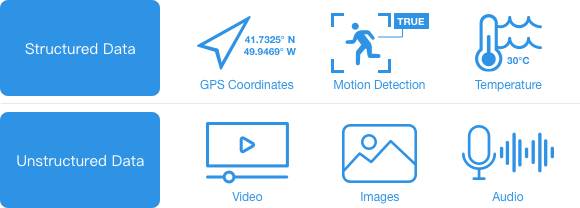
Data is transmitted along with the time of collection to form an event. Those events are then sent to edge computing devices with Gorilla IVAR® or other computing solutions for preprocessing and then forwarded for analysis in public, private, or hybrid servers. Here, the unstructured video and image data is transformed into structured data via deep learning. Events are stored in software-defined storage and correlated and categorized for use in biometric authentication, account management, device management, business intelligence, and more.
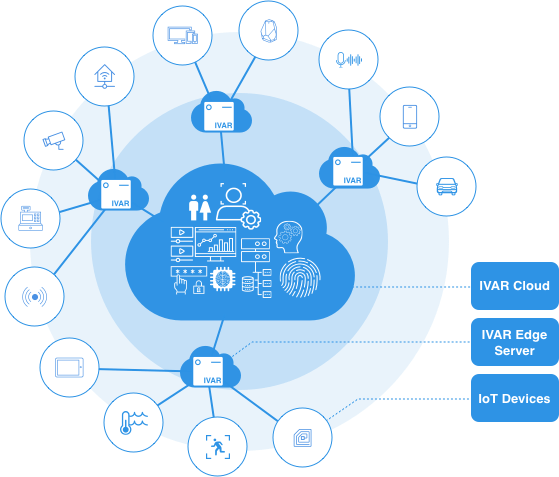
Gorilla Edge AI Technology is Different
Gorilla was the first to offer high-performance video analysis optimized by the Intel® OpenVINO™ toolkit to take edge computing & IoT data and business intelligence into the age of machine learning. The advent of this technology allows edge devices to do far more efficient computing at the edge without needing GPUs.



Edge AI Computing
As we discovered earlier in this article, edge AI can mean many things. A perfect example of this is how IVAR uses a combination of machine learning and deep learning through customizing MobileNet SSD, ResNet and more to provide various and highly accurate analytics in edge computing.
Intelligent Video Analytics
Drawing out event information from a video camera’s live feed is the goal of many video analytic solutions. How that is achieved is a multi-step process. Gorilla uses multiple AI algorithms collaborating to deliver intelligent video analytics (IVA) that transform data into actionable, real-time insights with people, vehicle, and object identification capabilities.
While some edge AI video analytic solutions require use of specific or proprietary camera brands, edge devices, or expensive GPUs, Gorilla’s edge AI technologies like we see in IVAR can process video from various sources or archived video and operate efficiently on small systems or large systems.
Recap and Thoughts on Edge AI
To the uninitiated, computing on the edge and implementing AI and computer vision sounds like a daunting feat. After exploring what these terms really mean and how they are used, it’s really not intimidating at all.
Edge computing puts these millions of devices that are already in place to good work. Efficient edge AI computing has direct impacts on deployment costs and maintaining balanced network processing. These solutions, as we see in what Gorilla has available, are driving automation and revealing insights to human operators. Using machines to handle repetitive chains of events (which require immediate responses) give us the ability to see patterns hidden in human behavior.
All in all, the reach, possibilities, and power of edge AI computing like video analytics are well at hand.
Further Reading on Edge AI
For deeper insight into the tech and to explore some examples in use today, check out our whitepapers, read some of our case studies, or contact us directly for more information.


